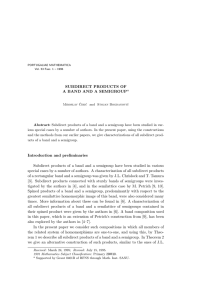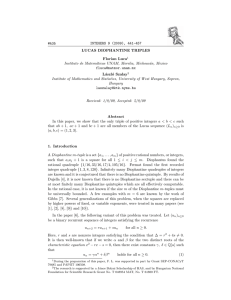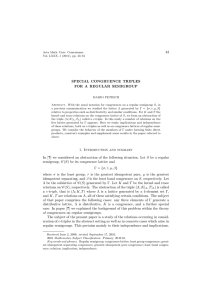Document 10507992
advertisement
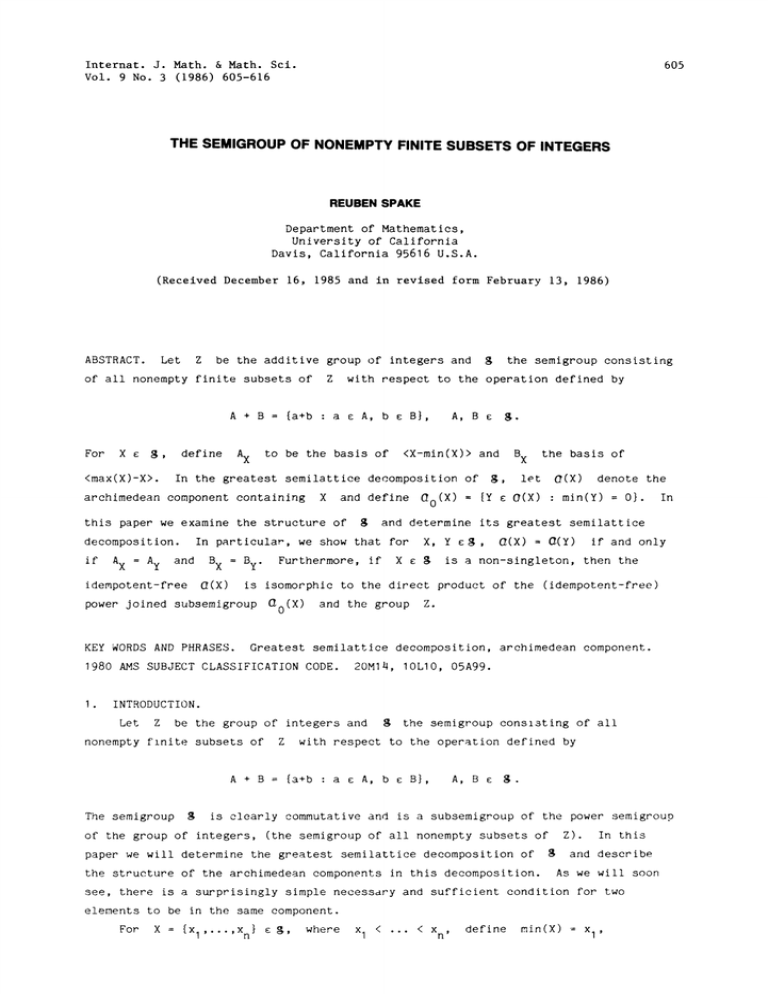
Internat. J. Math. & Math. Sci.
Vol. 9 No. 3 (1986) 605-616
605
THE SEMIGROUP OF NONEMPTY FINITE SUBSETS OF INTEGERS
REUBEN SPAKE
Department of Mathematics,
University of California
Davis, California 95616 U.S.A.
(Received December 16, 1985 and in revised form February 13, 1986)
Let
ABSTRACT.
Z
be the additive group of integers and
Z
of all nonempty finite subsets of
A
For
X
,
<max(X)-X>.
A
X
define
{a+b
B
g
the semigroup consisting
with respect to the operation defined by
B},
a e A, b E
to be the basis of
.
A, B e
B
<X-min(X)> and
In the greatest semilattice decomposition of g,
X
archimedean component containing
and define
this paper we examine the structure of
Go(X)
[Y
X
the basis of
let
(X)
(X)
denote the
min(Y)
0}.
In
and determine its greatest semilattice
(Y) if and only
(X)
In particular, we show that for X, Y
g
is a non-singleton, then the
if A
Ay and BX By. Furthermore, if X
X
is isomorphic to the direct product of the (idempotent-free)
idempotent-free (X)
decomposition.
Go(X)
power joined subsemigroup
KEY WORDS AND PHRASES.
and the group
Greatest semilattice decomposition, archimedean component.
1980 AMS SUBJECT CLASSIFICATION CODE.
I.
Z.
20M14, IOLI0, 05A99.
INTRODUCTION.
Let
Z
g the semigroup conslsting of all
be the group of integers and
nonempty flnite subsets of
A
B
Z
with respect to the operation defined by
{a+b
A, b e B},
a
A, B e
.
is clearly commutative and is a subsemigroup of the power semigroup
The semigroup
of the group of integers,
the structure of the archimedean components in this decomposition.
In this
Z).
(the semigroup of all nonempty subsets of
paper we will determine the greatest semilattice decomposition of
and describe
As we will soon
see, there is a surprisingly simple necessary and sufficient condition for two
elements to be in the same component.
For
X
{x
x
n}
where
x
<
< x n’
define
rain(X)
x
R. SPAKE
606
max(X)
x
x
integers
gcd(X)
and
n’
gcd(X)).
[a,b]
<
b.
For
m e
Z+
define
U
{x
Z
< x <
a
b}
A singleton
Z+
Let
8 will be identified with the integer it contains.
of positive integers and define
a
O, gcd(X u {0})
gcd(O)
(where
xn,
element of
to be the greatest (non-negative) common divisor of the
Z
a, b
if
let
<U>
denote the semigroup generated by the set
mU, m’U,
and
Z
8,
g
mU
with
U,
and for
as follows:
m
U,
U
be the set
u e U},
{mu
m*U
Z
and
m
Z/<-m,m>.
m
It will also be convenient to define
{-u
-U
U}.
u
In the greatest semilattice decomposition of 8,
A.
archimedean component containing
n e
and
Z+
<
(A)
(lower) semilattice as:
X
(equivalently:
(A)
let
denote the
<
As usual, define the partial order
(B)
if and only if
nA
for some (all)
Y e (A)
B
C
X
(A)
on the
C
for some
g
8
Y e (B)).
and
We refer the reader to Clifford and Preston [2] and Petrich [3] for more on the
greatest semilattice decomposition of a commutative semigroup.
(A)
is the only idempotent and indeed the identity,
Observe that since
is idempotent-free if
A
0
is a
non-singleton, ((0) consists of all the singletons in
Z).
8 and in fact (0)
x e Z},
8 are of the form {{gx}
Finally, note that 8 is clearly countable,
Furthermore, if follows that the subgroups of
g
where
is a non-negative integer.
but this of course does not imply that there are also infinitely many archimedean
However, as will soon be shown, there are in fact infinitely many
components.
components.
2.
GREATEST SEMILATTICE DECOMPOSITION.
For
X e
<max(X)-X>.
,
A
Note that
observe that
A
A
define
A
least positive integer in
A
Given sets
A
X
A
{0}
X
if and only if
X
(if
A
X
a
{0}),
X
and
and
B
B,
B.
X
and
B
the basis of
X
is a singleton.
elements, where
and similarly for
B
gcd(AX)
gcd(X-max(X)), it follows that in general
gcd(X-min(X))
that
B
X
is a finite set with at most
X
<X-min(X)>
to be the basis of
X
X.
a
is the
Since
gcd(Bx).
it is clearly not always possible to find an
However, we do have a positive result.
Also
X
such
First we need the
following lemma.
LEMMA 2.1.
Let
S
be a positive integer semigroup with respect to addition.
The following are equivalent.
(i)
S
(it)
gcd(S)
(iii)
If
contains
[
m
such that
x
>
m
x
implies
S.
I.
is the least element of
S,
then
S
contains
SEMIGROUP OF NONEMPTY FINITE SUBSETS OF INTEGERS
c
gcd(S)
suppose
(mod )
c
such that
I, then
{b 1,...,b
B
and let
evidently (i i) follows.
n}
e [0,-I].
fo___[r
m, m+1 e S,
then
be a basis with
b
Clearly (i) implies (ii), since if
PROOF.
b
c_
O
Thus assume
.
> I.
b
607
gcd(S)
<
Next
I.
<
bn.
If
n >
This implies
n
and hence there exist
Yi
c.
-
(mod b
xi
I)
x
Xl,...
for
such that
n
[1,n].
e
I.
Let
c
I
j:l
I)
Note that
yjbJ
and for
[I,
e
e S.
c
bl-1]:
i(j:1
o
c_ I}
x m
(mod ).
Thus
implies
>
k
0
There exists an
m.
define
c
0
0
Let
such that
However, since
x
> c.
this
This completes the proof.
{a
A
I).
[0, -I]
e
k e Z.
for some
k
x e S.
Let
PROPOSITION 2.2.
(mod b
Finally, suppose (iii) holds.
c.
and hence
bi-I]
such that
(mod b I); since,
xj)bj)m
j:IY (yj
x.j b.j
x
and
x
[I,
0
n
y
Therefore (ii) implies (iii).
max {c
Yi >
e
-
c
Furthermore,
n
c
Choose
and for
b
O
n
(mod b
m
x b
iI
a
{b
B
and
n
b
m}
b_e elements
of
satisfying
(i)
a
(ii)
gcd(A)
(iii)
a
A
X
B
and
r
and
B
and
B
B,
X
for all
p-b c
X
A
Let
for all
for all
A u(r-B)
e-idently
such that
A
<b
A u (r-B)
<A>
X
[2,n], j c [2,m].
fo___[r
bj_l>
g*A
gcd(A)
is an element of
A
{0}.
B
and
B
A
q
p
max {max(A
A I, b c B
I.
a
with
I),
and max(X)-X
B u(--A)
B
X
B.
max(B
Hence, if
Sznce
r
>
ged(A) > O.
gcd(A).
g
where
q
such that
I)}.
r
max
<B>.
A
is an element with
Thus we assume
g*B I,
a e A, b c B.
and
{r}
X
O,
there exists a positive integer
> q.
<AI>
r-b c <A>
X
s
bj
since necessarily
I,
< b m’
<
b
B.
X
be such that
gcd(B I)
ai_1 >,
For the case where
PROOF.
< an’
gcd(B),
<a
Then there exists an
A
<
a
0
b
Then
gp,
{an,bm}
s c
p-a
then
A
X
Let
A
gcd(A I)
Since
<AI> and s c <BI>
<BI> and
r-a c <B>
and
it follows that
By the definition of
A
and
B,
608
R. SPAKE
The next result is the key theorem which gives a necessary and sufficient
8
condition for two elements of
Fo___r
THEOREM 2.3.
B
X
then
and
Y
and
V
gcd(AU)
min(X)
if and
I.
Let
(mod b)}
for
min(B i),
c
Ay
A
X
with
min(Y)
0
a
and
Ay
onlx if Ax
and
<Au>
{x e
e [0, a-l]},
max {c
Also
So assume gcd(A
where
g
gcd(Ax).
and
define
d--max
and
gcd(A X)
If
(I(Y).
(mod a)}
x m
b-l].
a-l], j e [0
[0
g’V,
Y
and
Without loss of
max(Y).
max(X)
(I(X)
By.
X
be the least positive integers in
b
A.
Define
e
g*U
X
B
and
and
are singletons and thus
be such that
respectively.
Z+
X, Y e 8
Suppose
generality, assume
r
(I(Y)
(l(X)
X, Y e 8,
By.
X
PROOF.
U
to be in the same archimedean component.
ci
B.
A
U
O.
Let
Note that
B U,
and
{x e
<Bu>
--min(A i)
x m j
d
e [0, b-l]}.
{di
>
x)
O,
Choose
m,
such that
max {c,d}
(ii)
c.
(iii)
do e r(max(U)-U)
n
Finally, let
rU
<
max(U)
(i)
(m+1)min {a,b},
e [0, a-l],
for all
e [0, b-l].
for all
m+r.
By the definition of
n,
evidently
a-1
{x e A.
u
x
< c-a}
u [c-a+1, ma]
i--O
m
a-1
u
u
{c
ja}
nU
j--o i--o
and similarly
b-1
{x e B.
u
<
x
n(max(U)-U).
d-b} u [d-b+1, mb]
i=O
Also, observe that
definition).
for all p
>
Since
c
sU
a
c
max(U)
and
<
d
s(max(U)-U)
b
(m+1)a
and
d
max(U)
for all
< (m+1)b,
0
P
u [c-a+1
max(U), ma
max(U)]
i=O
[c-a+1, ma
and similarly
p max(U)]
(n+p)U
s
E
Z/
(by
it follows that
SEMIGROUP OF NONEMPTY FINITE SUBSETS OF INTEGERS
[d-b+1, mb
Thus, for all q
>
p max(U)]
609
(n+p)(max(U)-U).
n
[c-a+1, ma
[n max(U)
+
(q-n) max(U)] u
mb, q max(U) + b-d-l]
qU.
In particular,
[c-a+1, ma
n max(U)] u
[n max(U)
mb, 2n max(U)
[c-a+1, 2n max(U)
It is clear that if
u e qU
with
u
<
+
c-a
b-d-l]
b-d-l]
q
and
2nU.
>
n,
then
a-1
{x e A.
u
u e
x
<
c-a}.
i=0
u e qU
Likewise if
>
u
with
q max(U)
b-d
and
>
q
n,
then
b-1
{q max(U)
u
u e
<
x e B., x
x
d-b}.
i=O
Hence
a-1
u
2nU
{x e A.
x
< c-a} u [c-a+1,
2n max(U)
b-d-l]
b-1
u
{2n max(U)-x
u
x e B i, x
i=0
Therefore,
2nX
2nY
and
Conversely, suppose
s, t e
Z+
(X)
Since necessarily min(S)
(X)
(Y).
min(T)
Ayc__
and similarly
and
2nV.
Then there exist
S, T e S
and
such that
Y-min(Y)+S
t(Y-min(Y))
X
d-b}
(Y).
s(X-min(X))
A
<
Ay
X
<Ay>.
we have
A
A
X
and
T.
O, it follows that
Y-min(Y)
Consequently,
Ay.
X-min(X)
<Ax>
S
__c
<Ax>
<Ay>
and hence by the definition of
Similarly it is easy to show
B
X
By
and his
completes the proof.
Perhaps a brief example will help illustrate the simplicity of the conditlon
2.3. Let W
{4, 6, 69, 85, 86}. Then
given in Theorem
Y
{-10, -8, 22, 55, 57},
X
{3, 5, 29, 68, 69}, and
R. SPAKE
610
{0, 2, 32, 65, 67}, max(W)-W
{0, 2, 26, 65, 66}, max(X)-X
{0, 2, 65, 81, 82}, max(Y)-Y
W-min(W)
X-min(X)
Y-min(Y)
Hence,
A
A
W
G(X)
G(Y)
{0, 2, 35, 65, 67},
{0, I, 40, 64, 66},
{0, I, 17, 80, 82}.
{0, 2, 65}, BW
{0, 2, 35}, and B X
By {0,1}. Therefore
(W)
(X). Actually, (X) < (W) by our next theorem.
Ay
X
and
2.3 we can determine when two archlmedean components are related
Using Theorem
with respect to the order on the semilattice.
THEOREM 2.4.
Th___e followin ar__e
(i)
G(X) < (Y).
(ii)
Ay c_
(iii)
AX+ Y
PROOF.
Suppose
equivalent.
and
By _c
<Bx>.
A and
X
BX+ Y
B
<Ax>
G(X)
< G(Y).
X.
Z+
n e
such that
0,
Ayc__
<Bx>.
By
Similarly
and
U.
Y-min(Y)
n(X-min(X))
min(U)
Since
U e
There exist
Y-min(Y) + U
__c
<Ax>.
Suppose next that assertion (ii) holds.
Y-min(Y)
_c <Ay> c__
Then
<Ax>
and thus
A u X
X
X + Y- min(X+Y)
<Ax>.
X
where
then by Theorem
Hence
2.3
X+Y
Observe that clearly
(I(X)
and
G(Y).
By
A
G(X);
Ay
and
By
B
X
<
B
(Y)
X.
Finally, if (iii) holds,
and the proof is complete.
is a sufficient condition for
Since
G(X)
G(Y)
are finite sets, it is relatively easy to determine when
for all
Define
of
G(X).
U
a,
X e
Go(X)
and hence
{Y e G(X)
(0,I)
min(Y)
Moreover, since elements of
where
U e
Ay
via
Also, as the trivial case of Theorem 2.4, we have
Go(X)
and
a e Z,
proof of Theorem 2.3, apparently if
joined.
G(X)
that is,
A
X
BX+ Y
Likewise
X.
However, it is not a necessary condition (see Spake [4]).
Theorem 2.4 (ii).
G(0)
AX+ Y
is an ideal of
0}
G(X)
and note that
We therefore immediately have
is a
is a subsemigroup
can be uniquely expressed in the form
evidently
X
Go(X)
G(X)
O(X)
non-singleton, then
Z.
Recalling the
G0(X)
is power
SEMIGROUP OF NONEMPTY FINITE SUBSETS OF INTEGERS
THEOREM 2.5.
non____-singleton,
611
componen.t. O.(X), where X is a
of
product
t__o th___e direc____t
th__e Idempotent-free power
The idempotent-free archlmedean
is
isomorphic
(Io(X)
joined subs..emigroup
Z.
and the group
We complete this section with a brief summary of the greatest semilattice
decomposition of
an;
{((a
W
Let
8.
bm ))
b
al <’’’<an’ 0 b1<...<bm,
gcd(b 1,...,bin )’
a n)
e Z, 0
bj
ai,
gcd(a I,
e [2,n],
for
Define a partial order
an;
((a
{c
<
<a
a
Also, define the map
{a
a
A
n
((c
>
{b
j e
b
dq}
{d
<b
bj
bj_l>,
[2,m]}.
m}
B
if and only if
<b
b
m
>.
((a 1,...,an; b 1,...,bm ))
(X)
by
dq))
d
Cp;
and
W
8
and
X
n
and
as follows:
bm)) <
b
Cp
W
on
ai_l >
<a
a
where
Using our preceding results we have the
X.
following theorem.
THEOREM 2.6.
W
(X)
(X)
<b
is
The map
the greatest semilattice homomorphism of 8,
an; b1’’’’’bm)
((a
<
(Y)
Cp}
{c
if and only if
(Y)
and
with
Moreover, if
being the greatest semilattice homomorphic image.
Cp; dl,..., qd )),
((c
<a
a
and
on
n
>
{d
and
d
I’
then
q
1,...,b m >.
We further define two congruences
X 6 Y
if and only if
X
X
if and only if
(X)
Y
satisfying
min(X)
0
and
if
g1(x)
Si
gi
the spined product of
y e S 2,
z
(Y)
z e Z,
for some
and min(X)
is the semilattice
isomorphic to the direct product
spined product:
Y
as follows:
min(Y).
is isomorphic to the subsemigroup
/6
Observe that
6
g2(y)}
S
T
and
in which
Using our results we have
of
W
and
Z.
of 8 consisting of
W
o(A)’s.
of
Also,
X
/
is
Next, recall the definition of
2)
S
then
onto T (i
is a homomorphism of
S
2
with respect to
(x1’ Yl
(x2’ Y2
gl
and
(Xl
g2
is
x2’ Yl
{(x,y): x e S I,
Y2 )"
612
R. SPAKE
THEOREM 2.7.
3.
i__s isomorphic to the spined product o__[f ] and
The semiroup
respect to M
with
W
and
W.
}
STRUCTURE OF THE COMPONENTS.
(0)
The structure of
(0)
is clear, since
(X)
investigate the structure of
X
when
PROPOSITION 3.1. Fo____r X, Y e 8, Y e (X)
A u X
(i)
Y-min(Y)
where X __c
X
For
x
x.
{x 1,-..,x
X
fd(X)
and
x
8,
x
n
We begin with a
n
where
2
>
BX,
<Ax>
<Bx>.
and
<
x
and
id(X)
Notice that
n-1
and
X
where
only if
if and
< Xn,
fd(X)
and
id(X)--
define
are the least
Recalling the proof of Theorem
respectively.
we evidently have
gcd(Ax).
g
x _-- j (mod b)}
Y e (I(X)
<Au>
{x e
A.
g’U,
X-min(X)
be such that
x m i (mod a)}
{x
B
and
<Bu>
fd(U).
id(U) and b
[0, a-l], j e [0, b-l], where a
max {min(B i)
[0, b-l]}. Then
[0, a-l]} and d
i)
V
if and only if there exist
8
and
n
o
e
Z+
Y-min(Y)
such that
g*V
> no
n
and for all
U
be a non-singleton and
Define
for
max {min(A
c
X
Let
THEOREM 3.2.
where
Let
u X 2,
X
n}
A
X
positive integers in
2.3,0
B
In this section we
2.3.
general result from Theorem
max(Y)-Y
Z.
is a non-singleton.
a-1
nV
{x e A.
u
x
< c-a} u [c-a+1,
b-d-l]
n max(V)
i=0
b-1
u
u
{n max(V)
x e B i, x
x
i=0
< d-b}.
Next we reproduce several definitlons and facts from Tamura [5] that we will
need in the following development.
We direct the reader to [5] for a more complete
discussion of the notions which follow.
idempotent-free archimedean semigroup.
Let
T
be an additively denoted commutative
Define a congruence
T,
on
Pb
for fixed
b, as
x
Then
T/b
Pb
G
b
standard element
y
if and only if
nb
x
mb
y
for some
is a group called the structure group of
b.
T
Also, define a compatible partial order
n, m
g
Z+.
determined by the
<
on
T
as follows:
SEMIGROUP OF NONEMPTY FINITE SUBSETS OF INTEGERS
<
x
y
if and only if
x =nb
T/Pb
{T},
for some
y
Z+.
n e
b
T,
u
T
Then
eG
equivalently
A e G b,
613
T
where each
is a lower
b
<.
semilattice with respect to
In fact, for each
<, (a
tree without smallest element with respect to
T
G b,
b
forms a discrete
discrete tree, with respect to
b
<,
is a lower semilattice such that for any
<
c
b
the set{x
d
<
c
b
finite chain).
n
Finally, we define a relation
x
y
T
on
nb+ x =nb + y
if and only if
d}
is a
b
as follows:
for some
Z+.
n
T.
is the smallest cancellatlve congruence on
The relation
<
x
b
We continue our development with the following theorem.
A e
be a non-singleton with
{Io(A)
determined by the standard element
Let
THEOREM 3.3.
The structure group of
min(A)
0
A
gcd(A).
g
and
Z
is
where
m’
m-1
max(A)/g.
m
(mod m)}
(Io(A)
Moreover,
u O
a
where
{X {2 (A)
0
i=0
max(X)/g m
<.
respect to
is a discrete tree without smallest element with
A
(A)
Furthermore, the structure group of
ZSZ
V
a
id(C)
B.j
{x
U, V e
Let
g*Vl,
where
and
Suppose
x
c+d
max(U
max(U
I)
gcd(A).
g
C, U I, V
and
<Ac>
{x e
Ai
Also, let
A
be such that
(mod a)}
x m
max {min(A
c
g’C,
[0, b-l],
e [0, a-l], j
For
define
j (mod b)}.
E
U
I)
max(V
I)
(mod m),
and
[0, a-l]} and
i)
max(V I)
max(U I)
km
max(C).
m
where
with
k
>
0.
Without loss of
There exists
such that
a-1
pC
,J
{x
A.
x
< c-a}
u [c-a+1, pm+b-d-1]
i=0
b-1
u
u
i=0
{pro
x
x
B i, x
<
g*U I,
where
e [0, b-l]}.
i)
generality, assume
>
a0(A)
fd(C),
b
<Bc>
d--max {min(B
p
A
m
PROOF.
and
determined by the standard element
d-b}.
is
R. SPAKE
614
U
Since
(10(C),
e
it follows that
a-1
{x e A.
u
<
x
b-d-l]
c-a} u [c-a+1, max(U I)
i--O
b-1
{max(U
u
u
i--O
V
and similarly for
I)
<
x e B i, x
x
d-b}
Hence
a-1
U
A.I
{x e
u
pC
i=O
< c-a} u [c-a+1, pm+
x
b-d-l]
max(U I)
b-1
u
{pro
u
+
max(U
i--O
I)
x
<
x e B i, x
d-b}
a-1
u
{x e A
x
<
max(V
c-a} u [c-a+1, (p+k)m
i--O
I)
b-d-l]
+
b-1
u
{(p+k)m
u
+
i=O
max(V I)
x e B i, x
x
<
d-b}
(p+k)C.
--V
rA
U
Conversely, if
(p+k)A.
V
pA
U
Consequently,
V + sA
r, s
for some
E
Z+,
then
max(U) + rgm--max(V) + sgm.
glmax(U)
Since
X
A
C
o(A)
X e
max(U)/g m max(V)/g (mod m). By
C) c-a+1} and t E Z+,
evidently
max {max(A
t
C)
+ d-b+1, max(B
G0(C) with max(X)
@0(A) with max(X)/g m
B C) e
u (t
there exists
of
glmax(V),
and
Proposition 3.1, if
It follows that for each
to
(mod m).
A
determined by the standard element
Using the above, it is clear that for
X
and
rA
Y
sA
for some,
(max(X)-min(X))/g
-=
r, s e
is
e
then
Zm,
Therefore, the structure group
Zm.
X, Y e (A),
Z+
if and only if
(max(Y)-min(Y))/g (mod m).
This completes the proof.
We conclude this paper with two related propositions.
min(X)
min(Y)
SEMIGROUP OF NONEMPTY FINITE SUBSETS OF INTEGERS
PROPOSITION 3.4.
defined
max(U)
b_y h(U)
o__n
relation
Le__t X
o(X)
be a non-singleton.
615
The homomorphism
is the greatest cancellative homomorphism.
defined
U n V
That is, the
b_y
congruence.
max(V)
max(U)
if and only if
is the smallest cancellative
Z+
Oo(X)
h
Furthermore,
th__e
relation
o
o__9_n
(X)
defined by
V
U
min(U)
if and only if
max(U)
and
max(V)
congruence.
is the smallest cancellative
min(V)
The semigroups
o(X)/ and
U
be such that
are
(X)/o
-semigroups.
Let
PROPOSITION 3.5.
g’U,
b
gcd(AX).
g
where
fd(U),
max
{ci:
e [0, a-l],
Fo___r
(mod a)
U)
(,o(X)
homomorphic image of
b-l],
{di:
max(B U) +
e [0, b-l]}, m
is
c-a+1}.
X-min(X)
where
a
id(U)
<Au>
and
<Bu>,
d. m j (mod b).
and
max
+ d-b+1,
j e [0,
to be the least integers in
c. m
[0, a-l]}, d
max {max(A
p
and
e
be a non-singleton and
ci --and dj
define
respectively, such that
c
X
and
Let
max
{max(Au), max(Bu)},
Then the greatest cancellat[ve
isomorphic to the following positive integer
semigroup:
C= {r
p-2]
e [m,
for some
if
r-y
r
then
u {r e Z
[m, p-2]
(where if
PROOF.
x e A U, y e B U,
for all
r
-
_>
j e
(mod a),
y
c
is not defined then
o(X)
cancellative homomorphic images, since
max(Bu)}.
AU, y
C
Since
A
U
c_
V
U.
and
B
U
c_
t
C= {r e Z
Propositlon 3.4.
A
U
>
x+d.
e
and
[0, a-l],
(r-B
U)
e
r
> p}).
(Io(U) have isomorphic greatest
(,o(X) (Io(U). Let V e o0(U) and
V, it follows that t > max {max(Au),
and
Thus, by the definition of
then evidently
for some
r
j (mod b),
i}
Moreover, using Proposition 3.1,
e B
then
-
> p},
First, observe that
max(V).
[0, b-l],
i__[f r-x
(o(U).
t
x e
<Bu>
c.
and
d.,
and
t
t e C.
y e
<Au>
for all
Furthermore, if
Consequently, the proof is complete by
R. SPAKE
616
REFERENCES
Power Semigroups, Math. Japon. 12(1967) 25-32.
I.
TAMURA, T. and SHAFER, J.
2.
CLIFFORD, A. H. and PRESTON, G. B.
Amer. Math. Soc., 1961.
3.
PETRICH, M.
4.
SPAKE, R. Idempotent-free Archimedean Components of the Power Semigroup
of the Group of Integers I, to appear in Math. Japon. 31__.(May 1986).
5.
TAMURA, T. Construction of Trees and Commutative Archimedean Semigroups,
Math. Nachr. 36(1968) 255-287.
The Algebraic Theory of Semigroups,
Introduction to Semigroups, Merrill,
1973.
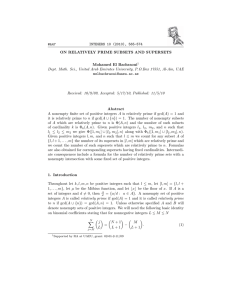


![5.5 The Haar basis is Unconditional in L [0, 1], 1 < 1](http://s2.studylib.net/store/data/010396305_1-450d5558097f626a0645448301e2bb4e-300x300.png)


